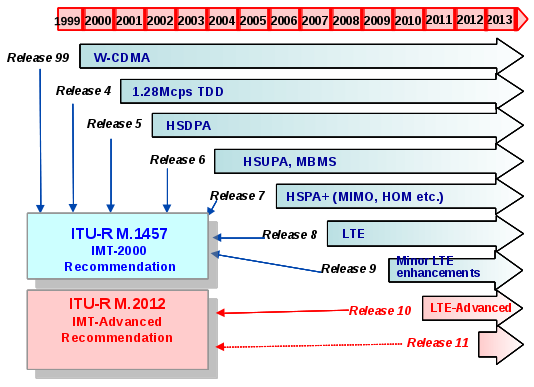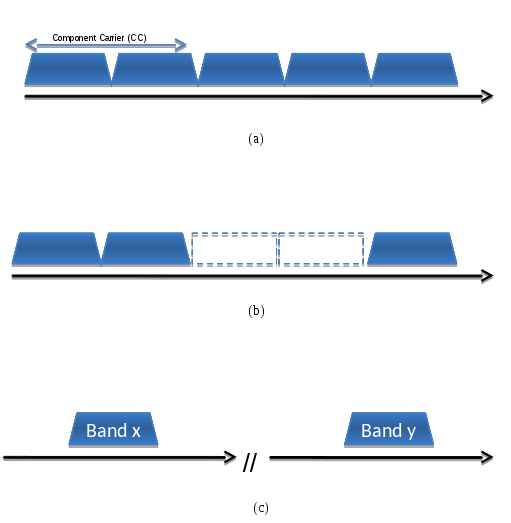LTE Advanced: A Quick Look at Releases 10 to 12
4G and “Real” 4G
3GPP LTE Advanced (LTE-A) is intended to reach or surpass the ITU-R IMT-Advanced performance requirements. Many LTE operators call their Release 8 or 9 network a 4G network, but from the ITU standpoint, only those networks that comply with IMT-Advanced (Release 10 onward) are really 4G [see 1, 2]. (See References at the end of the Eogogics LTE-A Tutorial for the publications referred to in this article.)
LTE-A: Deployment History
The very first LTE-A testing emulator, able to generate and analyze LTE-A signals, was built by Agilent in 2011. However, It wasn’t until 2013 (second half) that many operators started rolling out LTE-A commercially. Korea’s SK Telecom, using Samsung’s Galaxy S4 smart phone, Korea’s LG U Plus, and Philippines’ SMART Communications were the first to deploy and test LTE-A. This was followed by LTE-A trials by Vodafone and EE in urban London. Later in the year, Telefonica and Vodafone launched their LTE-A testing network in Munich and Dresden.
Currently, all operators with sufficient spectrum are seeking 3GPP LTE approval to deploy Carrier Aggregation (CA). The 3GPP LTE RAN4 working group, in charge of defining the spectrum spec, has initiated more than 40 different band and carrier combinations as part of Release 11 and 12.
LTE-A: Standardization Effort
Figure 1 shows the 3GPP standardization timeline. Release 10 work proceeded in three stages. Stage 1, which included the definition of LTE-A requirements, was frozen in March ‘10. Stage 2, including the high level feature development, was frozen in Sept. ‘11, and stage 3, including detail protocol specs for LTE-A Release 10, was finalized in March ‘11.
To improve the user QoS in small cell environments and heterogeneous networks (HetNet), Release 11 requirements (stage 1) were frozen in Sept. ‘11, with stage 2 and stage 3 frozen in March ‘12 and Sept. ‘12, respectively. Completing the development of Coordinated Multi-Point operation (CoMP), initiated as part of Release 10, was also considered as an objective of Release 11.
To enhance mobility in heterogeneous networks, LTE-A requirements were frozen as Release 12 stage 1 in March ‘12. The second stage for Release 12 was frozen in Dec. ‘13 and stage 3 (final LTE-A stage) is expected to finalize in June ‘14. Currently, 3GPP LTE community is working on defining the scope for Release 13.

LTE-A: Release 10 Features
LTE-A makes the most significant leap in performance by exploiting CA and taking advantage of advanced topology networks, optimized heterogeneous networks with a mix of macrocells with low power nodes such as picocells, femtocells and new relay nodes. To this end, the following features were planned for Release 10:
- Scalable and flexible bandwidth extension up to 100MHz using CA, supported both inter- and intra-band.
- Enhancement in UL MIMO.
- Support for relay nodes for extending coverage by allowing far away User Equipment (UE) to send their data via relay nodes that can hear the eNB better.
- Portable/Local Area Network and mobility solutions.
- Air interface optimization (e.g. reference signal optimization).
- Automatic and autonomous network configuration and operation [Self Optimization Network (SON) enhancement].
- CoMP transmission and reception, referring to MIMO transmission and receipt coordinated between different eNBs (different sectors or different sites).
- Support of autonomous network and device test, and measurement using Minimization of Drive Test (MDT) and network management and optimization.
- Enhancement in interference management and suppression (enhanced Inter-Cell Interference Coordination or eICIC).
Perhaps, the most noticeable Release 10 feature is wider bandwidths using CA, where multiple Component Carriers (CC) are used to extend bandwidth up to 100 MHz. The physical layer parameters are shared among LTE-A CCs and LTE Release 8 carriers to allow backward compatibility between LTE-A and earlier releases. CA can be implemented either as contiguous or non-contiguous CCs. Contiguous carrier aggregation belongs to the same 3GPP band (intra-band Contiguous CC, see Fig 2.a), while the non-contiguous carrier aggregation could be done using CCs from either the same band (intra-band non-contiguous CC, see Fig 2.b) or from different 3GPP bands (inter-band non-contiguous CC in Fig. 2.c).

Fig. 2: CA (a) intra-band contiguous (b) intra-band non-contiguous (c) inter-band non- contiguous
LTE-A Release 11 Features
Release 11 focused its effort on enhancing the HetNet support and improving the CA functionalities. Moreover, to improve the experience of the users located at a cell edge in homogenous networks who suffer from decreasing signal strength compounded by neighbor cell interference, CoMP is designed to enable use of a neighboring cell to also transmit the same signal as the serving cell. The major release 11 features are:
- CA enhancements by introducing additional non-backward compatible carrier, named New Carrier Type (NCT), to enhance spectrum efficiency and improve HetNet support. Moreover, the timing advances for UL CA were enhanced in this release.
- Enhanced downlink control channel (E-PDCCH) to support increased control channel capacity, additional carrier type, frequency domain ICIC, beamforming and/or diversity.
- CoMP transmission and reception for homogeneous/heterogeneous networks.
- Further enhanced inter-cell interference coordination (FeICIC) by adding Cell specific Reference Signal (CRS) canceller from macro-cell, and non-zero power transmission for almost blank subframe.
- Interference Rejection Combining (IRC) UE receiver for improving the received performance.
- Enhancement of Minimization of Drive Tests (MDT) to provide mechanisms to collect radio and QoS measurements together with location information from eNB/UE to reduce operator costs for performing manual drive tests.
- RAN overload control for Machine-Type Communications (MTC) to protect the LTE network from potentially very large number of MTC terminals.
- Further Self-Optimizing Network (SON) enhancements to facilitate network optimization by adding procedures for inter-Radio Access Technology (RAT) mobility robustness optimization.
- Network Energy Saving to provide mechanisms to facilitate inter-RAT network energy saving.
- LTE RAN Enhancements for Diverse Data Applications to specify RAN improvements considering various data traffic types, e.g. those generated by smartphones.
- Further enhancements to H(e)NB mobility by supporting macro to HNB enhanced hard handover mobility and soft handover.
- In-Device Co-existence (IDC) designed to suppress interference within UE between LTE/LTE-A and the various other radio subsystems such as WiFi, Bluetooth, and the GPS receiver.
LTE-A Release 12 Features
Release 12, due to finalize in June’ 14, seeks to boost capacity. Some of the major Release 12 features are:
- Study on Provision of low-cost MTC UEs [3] based on LTE to provide reduced-bandwidth operation, reduced peak-rate, half-duplex FDD, reduced power consumption with less frequent mobility measurements, and therefore signaling load reductions.
- Further enhancement in DL MIMO for macro-cell eNB [4] by exploiting an increased frequency reuse and reduced interference in the spatial domain.
- 3D channel model to standardize a new 3D channel model [5] to allow for accurate system-level simulations of multiple antenna technologies. In this model, wireless channels for multiple antenna systems are modeled in all three spatial dimensions.
- Finalizing New Carrier Type (NCT) [6], started in release 11, targeting non-backward compatible carriers. One of the advantage of NCT is to avoid transmitting Common Reference Signals (CRS) in every subframe across the bandwidth continuously.
- Enhancement in small cell development [7] by exploiting the reuse of frequency resource by cell splitting. This would take care of large traffic and user variations in the cells, larger SINR dynamics, and increased handover rate in HetNets.
- LTE Device to Device Communication or D2D [8] to allow direct communication among UEs in close proximity. This feature not only saves energy, reduces interference, and extends coverage, but enables LTE services in public safety applications. D2D feature includes both proximity detection and actual communication. Note that in D2D communication, control signaling between the two UEs, which include initial access, authentication, connection control, resource reservation, etc., are handled by the network, not necessarily the UEs.
- 3GPP and WiFi co-existence [9], interworking, and offloading to improve the performance of WiFi devices, and reducing some LTE loads at the time of network overloading and congestion.
- Study on Network-Assisted Interference Cancellation and Suppression for LTE [10]. This feature enhances the performance of interference rejection feature as compared with Release 11 IRC, by exploiting network assistance.
- Further enhancement in positioning techniques by completing UL-based location based techniques and by introducing RF Pattern matching [11].
- Base Station (BS) RF requirements for Active Antenna System (AAS).
- Multicast-broadcast enhancement operation.
- Further enhancements to LTE TDD for DL-UL interference management and traffic adaptation.
- Group communication system enablers for LTE.
- Inter-eNB CoMP for LTE.
- LTE coverage enhancements.
- LTE TDD-FDD joint operation including carrier aggregation.
- CoMP operation for LTE with non-ideal backhaul.
- Study on RAN aspects of RAN sharing enhancements for LTE.
- … and more.
In Conclusion
Emerging trends such as social networking, cloud computing and storage, and video sharing, together with mobile computing will continue to put an enormous pressure on the cellular infrastructure. It is anticipated that at least a 30 fold increase in capacity, as well as additional services that will enhance the user experience, are required to make it all work. The LTE-A advanced project was initiated to meet this increasing traffic demand. LTE-A Release 10 and 11 have already been standardized and are in the process of hitting the marketplace. The LTE-A release now in development is Release 12 which is expected to finalize around June’14. The 3GPP is planning to develop future releases including Release 13, starting from September 2014, to enable the mobile cellular systems to continue to offer excellent social networking experience, to lower the cost and energy consumption per bit of transmission, and to meet future challenges.
Editor’s Note: Dr. Olfat is our 4G specialist with 25+ year experience as an engineer, researcher, engineering executive, and instructor. In addition to WiMAX and LTE, his teaching repertoire also includes GSM/HSPA/UMTS, Satellite Communications, and NextGen Networks. The Eogogics 4G curriculum includes three dozen instructor-led and half a dozen e-learning courses. An updated LTE-A course is among the latest additions to this curriculum.

